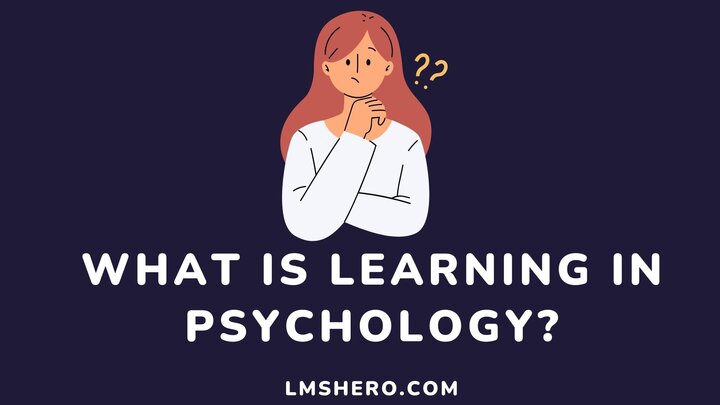Learning in psychology is typically characterized as a mildly permanent change in behavior as a result of experience.
Learning is a groundbreaking new approach to psychology that shows how experience can change behavior permanently. It is unique because it’s based on the idea that the environment is constantly influencing and interacting with the individual.
This means that any changes you make in your environment will have a lasting impact on the way you behave.
Let’s take a closer look at what learning in psychology mean, the types available, and strategies teachers and parents can use to take advantage of it.
What is Learning?
The process of modifying one’s behavior or skills as a result of experience is known as learning.
Learning is an adaptive process in which our nervous system adapts our behavioral responses to environmental information, allowing us to function in our environment. As a result of external stimuli, the process starts in our nervous system.

As neuronal networks are reinforced, pruned, activated, or redirected, our behavioral responses might change.
Natural activities such as instincts and reflexes happen even without instruction. Learning, on the other hand, is a change in behavior or knowledge brought about by experience.
Behavioral psychology focuses on observable activities that individuals can learn, rather than attempting to explain underlying variables such as perceptions and feelings.
Types of Learning in Psychology
The three basic types of learning are classical conditioning, operant conditioning, and observational learning.
Associative learning occurs when people create connections between experiences that occur at the same time. Classical and operant conditioning are two types of associative learning.
1. Classical conditioning
Classical conditioning is a learning process in which humans learn to correlate occurrences that tend to happen regularly with the event that follows and hence learn to anticipate them.
In research with dogs, Ivan Pavlov notably trained (or conditioned) dogs to associate the sound of a bell with the arrival of a piece of meat. The conditioning is accomplished once the sound of the bell prompts the dog to salivate in expectation of the meat.
2. Operant condition
Operant conditioning strengthens or reduces people’s responses by rewarding or punishing them for their activities.
The term “law of effect” was developed by Edward Thorndike, who stated that actions with happy outcomes are more likely to be repeated, whereas behaviors with painful effects are less probable to happen.
To examine operant conditioning, B. F. Skinner used rats in a “Skinner box”. Skinner illustrated the effectiveness of rewards by keeping a starving rat in the Skinner box.
As the rat moved around it would pull a lever, and food would fall into a container next to the lever. After several trips to the box, the rats quickly learned to go straight to the lever.
The rats eventually realized that pulling the lever caused food to emerge, demonstrating that rewards have an impact on behavior. He discussed the differences between rewards and punishments, as well as the concept of extinction.
3. Observational conditioning
Observational learning is the act of learning through watching others, remembering what they’ve done, and then repeating it.
It can occur at any moment in someone’s life, but it is most frequent in childhood.
Children learn to behave and react by watching their parents and/or caregivers engage with others.
Observational learning has the potential to teach, reward, or discourage specific behaviors depending on a variety of factors.
It is a crucial component of how we acquire new skills and avoid unpleasant outcomes. However, there are some concerns that this type of learning could lead to negative results and behaviors.
What are Techniques Of Learning?
1. Visual learning
When information is in a graphic style, – for example lines, charts, graphs, symbols, and more, visual learners memorize it easier. Strong visual depictions of information structure assist visual learners.
Pictures, charts, textual instructions, and other visual elements entice visual learners to study and learn. “Spatial” learning is a term that describes this type of learning.
When information is expressed visually, those who learn by seeing have a better grasp of it. These are the students who write, create a list, and take account of what they’re doing.
2. Auditory learning
Auditory learners, often known as “aural” learners, love to hear information delivered through speech. These people prefer reading aloud to themselves and perform well in groups.
Auditory learners learn better when the material knowledge is accompanied by sound. Instead of taking notes, these students tend to listen to lectures, and they regularly use their own voices to stress thinking skills.
These students enjoy listening and speaking to themselves. They have excellent communication skills and self-assurance in their abilities to speak up and participate in class.
3. Learning by reading and writing
By concentrating on the written text, reading, and writing learners succeed with written material in workbooks, and other word tools.
These students are excellent report writers who perform best when they have access to written material.
Although there is some connection with visual learners, these students have more interest in writing, reading, creating notes, looking up terminology in dictionaries, and researching nearly everything online.
4. Kinesthetic learners
Kinesthetic learners are energetic and excel when most of their faculties are required during their work. People who learn while doing are kinesthetic learners.
The curriculum includes a practical learning approach therefore, these students excel in scientific subjects.
Kinesthetic learners, or sensory learners, learn through actions. To obtain a better comprehension of subjects, they enjoy playing out activities or touching and handling objects.
These students may have difficulty sitting quietly, yet they thrive at athletics or performing. While studying, they may have to take additional breaks.
What are learning disorders?
A learning disorder is a condition that makes it hard for a student to learn in a regular classroom. It can obstruct the development of literacy and arithmetic skills, as well as remembering, focus, and organization.
There really are no two individuals whose learning disabilities are the same. Sometimes, people refer to learning disorders as learning disabilities.
Types of Learning Difficulties
1. Attentional difficulties
Attention deficit disorder (ADD) and attention deficit hyperactivity disorder (ADHD) were previously grouped together as ADD. ADHD, on the other hand, has recently become a general label for attention issues, with and without hyperactivity.
A common sign of ADHD with hyperactivity is the inability to maintain focus for lengthy periods of time.
Children with ADHD are more likely to have poor impulsive behavior, jitter, and write sloppily. They are usually easier to notice in a group than a student with ADD who isn’t hyperactive, as the latter may not bring attention to themselves.
A student with ADD may seem to be focusing therefore, the learning disorder may go undiscovered until activities are done and test scores are poor.
Reading and comprehension, staying on target, obeying commands, finishing long assignments, and staying organized are all difficult for students with this disorder.
2. Dyslexia
Learning disorders, such as dyslexia, are one of the most prevalent learning difficulties. The most common type of dyslexia is phonological dyslexia, which influences how people split words into smaller parts.
It has implications on reading comprehension and can lead to difficulty with spelling and writing.
Although dyslexia is not directly associated with a lower IQ, linguistic difficulties can lead to children believing they are less knowledgeable than their peers, leading to low self-esteem.
Some of the symptoms of dyslexia include difficulties reading aloud, irregular vocabulary, forgetting one’s place on a page, a weak understanding of phonics, letter reversals, interrupted writing due to spelling difficulties, and a limited vocabulary.
3. Dyscalculia
Unlike dyslexia and dysgraphia, which are both vocabulary-learning problems, dyscalculia is a challenge with numbers. Simple mathematics might be difficult for children with dyscalculia.
They could be unsure about how to tackle Maths problems, balance equations, and also collect numbers, and perform the correct sequence, which can be challenging at times.
Just counting can be difficult, so it’s common for people with dyscalculia to include a calculator always to assist their learning.
When dyslexia and dyscalculia coexist, word problems become more difficult to read or understand, and number reversals become more common. This may add inaccuracies to the work, leading to a learner arriving at an incorrect answer.
When a student has both dysgraphia and dyscalculia, they may find it especially challenging to display arithmetic work in extended form. Writing basic arithmetic symbols, as well as certain geometric features of arithmetic, may be nearly difficult.
Finally, getting steps in the correct order can be difficult with dyspraxia and dyscalculia.
4. Dysgraphia
Dysgraphia prompts children to struggle with writing, which can lead to illegible handwriting. Writing is time-consuming, tedious, and unpleasant.
For individuals with dysgraphia, the physical alignment and planning parts of writing can be extremely challenging. Allowing blank space between written text is an example of this.
It can be difficult to stay inside the margins, use punctuation, and use uppercase and lowercase letters.
Dysgraphia is a condition in which children dread writing, notably in the presence of their peers. They may be self-conscious while writing on the board, produce less writing than is expected for written projects, and score poorly on written examinations.
Strategies Used to Help Students with Learning Difficulties
1. Multisensory learning
The use of sight, sound, and feel to gain knowledge is referred to as multisensory learning. When children can use all of their senses, they learn more efficiently.
It is easier for children to acquire and retain new knowledge when they can see a topic discussed, listen to it, and then explore it with practical learning activities.
2. Direct instructions
Direct Instruction is a teaching method in which teachers teach students just what they require. This method of teaching conveys information in a very straightforward manner, removing the possibility of ambiguity.
The student will also be taught how to apply what he or she has been learning. If the language concepts and patterns are addressed directly, the child will not have to assume or struggle to read or type a tricky word.
3. Separately teach reading and spelling
Teaching reading and spelling simultaneously appears to make sense. Reading and spelling, even with all of their similarities, require separate instructional techniques and durations.
Reading is simpler than writing, and teaching these disciplines separately benefits the majority of children.
By dividing these modules, students can go through literature as fast as possible whilst also taking the same or more time as necessary need to become proficient spellers.
4. One new thing at a time
The student’s brain can only process so much information if you overload it. Presenting one idea at a time helps students retain knowledge and abilities in long-term memory by taking into account their short-term memory limits.
As a result, it is easy to gain a great deal of helpful knowledge.
FAQs
What influences students’ learning and behavior?
Dialect and culture students’ behavior and learning.
Culturally responsive strategies build on students’ identities to increase engagement and performance. The strength of the instructor connection also affects students’ learning and behavior.
What is the difference between a learning difficulty and a learning disability?
A learning disability is a disorder that affects learning and intelligence in all parts of life, whereas a learning issue is a condition that prevents a specific type of learning but does not affect a person’s overall intellect.
Conclusion
Basically, people gain knowledge by acquiring or reshaping experiences while being influenced by psychological and physiological instincts. We learn in different ways because we have diverse ways of seeing the world.
Recognizing different learning patterns can have a significant effect on how educators interact with their students, organize social projects, and personalize learning to an individual student.
A few students may lag behind their counterparts if teachers do not recognize and respect these diverse learning styles which is partly due to the fact that their particular learning style has not been taken advantage of.
You can also read effects of learning on mental health.
I hope you found this article helpful. Thanks for reading.







